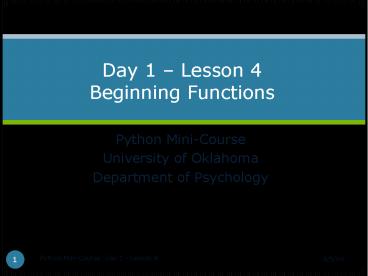Python Mini-Course PowerPoint PPT Presentation
Title: Python Mini-Course
1
Day 1 Lesson 4Beginning Functions
- Python Mini-Course
- University of Oklahoma
- Department of Psychology
2
Lesson objectives
- State the purpose of functions and modules in
Python - Use built-in functions
- Import modules and use imported functions
- Create custom void functions
- Discuss the concept of variable scope
3
Functions
- Function
- A named sequence of statements that performs a
computation or action - Functions are called by name
- Most functions accept inputs (arguments)
- Some functions return results (return value)
4
Functions
- Weve already seen some functions
- type()
- Type casting functions
- int(), float(), str()
5
Modules
- Module
- A file that contains a collection of related
functions - Python has hundreds of standard modules
- These are known as the Python Standard Library
(http//docs.python.org/library/) - You can also create and use add-in modules
6
Using import
- To use a module, you first have to import it into
your namespace - To import the entire moduleimport module_name
- To import specific functionsfrom module_name
import function_name
7
The math module
- The standard math module includes
- Number-theoretic and representation functions
- Power and logarithmic functions
- Trigonometric functions
- Hyperbolic functions
- Angular conversion
- Constants
8
Using the math module
- import math
- degrees 45
- radians degrees / 360.0 \
- 2 math.pi
- print math.sin(radians)
- x math.sin(degrees / 360.0 \
- 2 math.pi)
9
Dot notation
- Why did we use math.sin() instead of just sin()?
- Try this print sin(radians)
- Dot notation allows the Python interpreter to
organize and divide the namespace
10
More on Importing
- from math import
- print sin(2)
- Be careful when using the import command. It
can easily lead to namespace conflicts.
11
Creating your own functions
- You have to define the function
- Example
- def print_lyrics()
- print "I'm a lumberjack, and I'm okay."
- print "I sleep all night and I work all
day."
12
Composing functions
- def repeat_lyrics()
- print_lyrics()
- print_lyrics()
- repeat_lyrics()
13
Functions with arguments
- def print_twice(in_text)
- print in_text
- print in_text
- print_twice(Spam)
- print_twice(Spam4)
14
Variable scope
- Scope
- The enclosing context where values and
expressions are associated (partition in
namespace) - Variables inside functions are local
15
Variable scope
- def cat_string(part1, part2)
- cat part1 part2
- print cat
- cat_string(This , works)
- print cat
16
Documentation
- You can document functions in the code
immediately after the function header - Example func_doc.py
17
Before next time
- Practice creating and using your own functions
(try the exercises on pp 26-28) - Practice using the math module (see
http//docs.python.org/library/math.html for
documentation)

